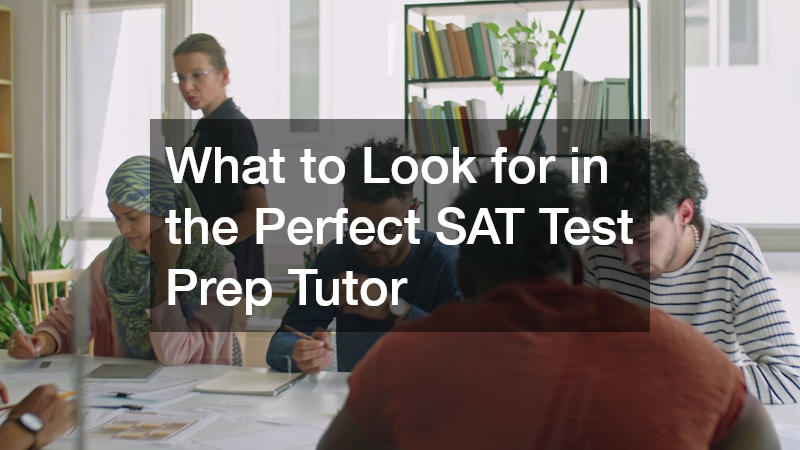
Finding the right SAT test prep tutor can make a significant difference in a student’s performance on the exam. With numerous options available, it’s crucial to understand the qualities and aspects that contribute to a successful tutoring experience. This article explores the most important factors to consider when searching for the ideal SAT test prep tutor.
Understanding the Tutor’s Educational Background
A tutor’s educational background can provide insights into their expertise and understanding of the SAT format and subjects. Tutors who have excelled in their own academic pursuits often bring a deeper level of knowledge to their instruction.
Additionally, an educational background tailored to the subjects covered by the SAT can ensure more comprehensive and effective preparation.
Many successful SAT tutors have majors in fields directly relevant to the SAT subject areas, such as mathematics, English, and critical reading. A tutor’s ability to explain complex topics clearly is often enhanced by their own studied expertise. Students benefit most from a tutor who can connect academic concepts to the real-world contexts they originate from, enhancing conceptual understanding.
Years of Experience in SAT Tutoring
The length of time a tutor has been coaching students for the SAT is an indicator of their proficiency and ability to address diverse student needs. Experienced tutors are likely to have encountered a wide array of learning styles and challenges, allowing them to adapt their approach effectively. This adaptability can lead to a more personalized and productive tutoring experience for each student.
Moreover, tutors with extensive experience might have developed a repository of resources and materials that can enrich the tutoring process. Tutors who have seen the evolution of the SAT over several test iterations understand the nuances and shifts in test content and format. This historical insight allows them to prepare students not just for current questions, but for understanding patterns that may appear in future exams.
Certification and Training
Certifications and professional training can highlight a tutor’s commitment to quality and ongoing personal development. Many SAT tutors obtain certifications from specialized prep organizations, demonstrating their mastery of test-related strategies and content. These credentials can be a testament to both skill and dedication in providing the highest level of educational service.
Tutors who pursue additional training often engage in continuous learning, attending workshops or courses that expand their resourcefulness and knowledge. This pursuit of knowledge implies that the tutor is not just relying on past success but constantly enhancing their abilities. By participating in ongoing education, tutors can stay updated on the latest teaching techniques and testing strategies.
Incorporating Multi-Modal Teaching Techniques
Employing various teaching techniques, such as visual aids, interactive exercises, and critical thinking prompts, can enhance learning. Multi-modal teaching recognizes that students absorb information differently, and adapting to these differences can facilitate deeper understanding. Effective tutors use a mixture of methods to make learning engaging and memorable.
For instance, incorporating visual aids like diagrams and charts can help students who are visual learners in grasping complex concepts more readily. Interactive exercises, including group discussions or problem-solving sessions, encourage active participation and critical thinking. Such interaction not only aids retention but also transforms the learning process into an enjoyable experience.
Critical thinking prompts encourage students to engage more deeply with the material, fostering analytical abilities that are key not just for the SAT but for academic success beyond it. These techniques help students translate abstract concepts into practical knowledge that can be applied in various contexts. By integrating diverse teaching strategies, tutors can stimulate cognitive engagement and increase student motivation.
Tracking Progress with Diagnostic Tests
Regular diagnostic tests administered by the tutor can help track improvements and adjust strategies as needed. These tests serve as checkpoints where both tutor and student can measure progress in specific subject areas. They also help identify persistent areas of difficulty that may need additional focus and attention.
Diagnostic tests enable tutors to customize future lesson plans and allocate time efficiently to topics requiring further review. By analyzing diagnostic results, tutors can pinpoint exactly where students diverge from their expected performance levels. This systematic approach allows for timely interventions and reinforces the student’s understanding.
Such frequent assessments also motivate students by showing tangible progress, helping maintain engagement and effort. Beyond the academic benefits, tracking progress can contribute to a student’s overall study skills, teaching them how to set goals and self-assess constructively. Aligning diagnostic outcomes with instructional objectives creates a focused path towards improved test results.
Comparing Pre- and Post-Tutoring Scores
A quantifiable increase in scores after a series of sessions can offer explicit proof of a tutor’s impact. By examining initial diagnostic scores compared to later assessments, students and parents can objectively evaluate a tutor’s effectiveness. This comparison gives a clear indication of the tutor’s ability to teach strategies that lead to tangible score improvements.
Selecting the perfect SAT test prep tutor involves considering various factors, such as experience, teaching strategies, and proven results. By focusing on these aspects, students and parents can make informed decisions that lead to significant improvements in SAT scores, ultimately enhancing college admission prospects. A carefully chosen tutor can offer not only academic guidance but also support and encouragement that contribute to long-term educational success.





